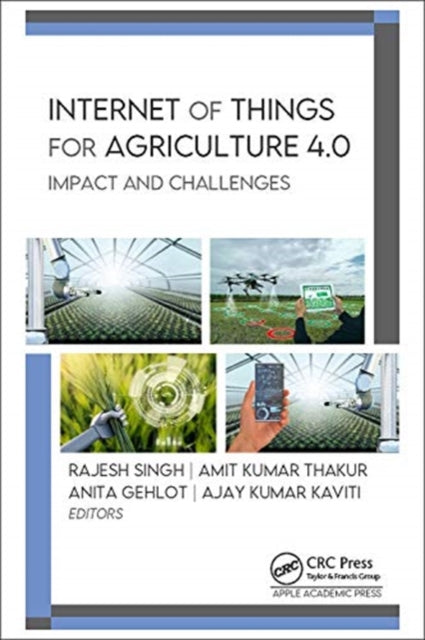Shulph Ink
Internet of Things for Agriculture 4.0: Impact and Challenges
Internet of Things for Agriculture 4.0: Impact and Challenges
YOU SAVE £6.29
- Condition: Brand new
- UK Delivery times: Usually arrives within 2 - 3 working days
- UK Shipping: Fee starts at £2.39. Subject to product weight & dimension
Bulk ordering. Want 15 or more copies? Get a personalised quote and bigger discounts. Learn more about bulk orders.
Couldn't load pickup availability
- More about Internet of Things for Agriculture 4.0: Impact and Challenges
This book explores the use of Wi-Fi and the Internet of Things in agriculture, highlighting their benefits in crop management, vehicle tracking, livestock monitoring, storage monitoring, and more. It also discusses the challenges of IoT in agriculture, such as wireless sensor network requirements, attacks, and vulnerabilities.
Format: Hardback
Length: 278 pages
Publication date: 24 February 2022
Publisher: Apple Academic Press Inc.
The Internet of Things (IoT) and Wi-Fi have revolutionized the agriculture industry, offering a wide range of uses and applications that have the potential to improve crop management, vehicle tracking, livestock monitoring, storage monitoring, and more. With the increasing availability of internet-enabled communications, farms and agricultural establishments can now take advantage of these technologies to streamline their operations and increase efficiency.
One of the key benefits of IoT in agriculture is the ability to collect and store data from various devices and sensors. This data can be used to monitor crops, optimize water use, plan effective fertilization strategies, and even predict crop yields. For example, IoT-based sensors can monitor soil moisture levels, temperature, and humidity, allowing farmers to make informed decisions about irrigation and fertilization.
Another area where IoT is making a significant impact is in vertical farming. Vertical farming involves growing crops in stacked layers, using controlled environments and artificial lighting. IoT-based systems can monitor the conditions of each layer, ensuring that crops receive the optimal amount of water, light, and nutrients. This can lead to higher crop yields, reduced water usage, and reduced land footprint.
IoT-based smart irrigation systems are also becoming increasingly popular in agriculture. These systems use sensors to monitor soil moisture levels and weather conditions, and then adjust the irrigation schedule accordingly. This can lead to significant water savings, as well as improved crop yields and quality.
Landslide susceptibility assessment is another area where IoT is being used to improve safety and productivity. IoT-based sensors can monitor the movement of soil and rocks, and then alert farmers to potential landslides. This can help farmers take preventative measures to protect their crops and property, and reduce the risk of damage and loss.
Automated aeroponics systems are also gaining popularity in agriculture. These systems use sensors and pumps to grow crops in a controlled environment, without the need for soil. This can lead to higher crop yields, reduced water usage, and reduced labor costs.
Crop survival analysis is another area where IoT is being used to improve crop yields and quality. IoT-based sensors can monitor the health and growth of crops, and then alert farmers to any potential issues. This can help farmers take timely action to address problems, and improve crop yields and quality.
However, IoT in agriculture also presents several challenges. One of the biggest challenges is the requirement for wireless sensor networks. Wireless sensor networks require a reliable and secure communication network, which can be challenging to establish in rural areas. Additionally, wireless sensor networks can be vulnerable to attacks and vulnerabilities, which can compromise the security of the data they collect.
Another challenge is the cost of implementing IoT in agriculture. The cost of purchasing and installing IoT devices can be significant, and may be beyond the reach of smaller farms or agricultural establishments. Additionally, the cost of maintaining and operating IoT systems can be high, particularly if the system is complex or requires a lot of data storage.
Despite these challenges, IoT in agriculture is still growing rapidly. Many companies and researchers are working to develop new technologies and solutions that can help to overcome these challenges and improve the efficiency and productivity of agriculture.
In conclusion, the Internet of Things and Wi-Fi have revolutionized the agriculture industry, offering a wide range of uses and applications that have the potential to improve crop management, vehicle tracking, livestock monitoring, storage monitoring, and more. With the increasing availability of internet-enabled communications, farms and agricultural establishments can now take advantage of these technologies to streamline their operations and increase efficiency. While IoT in agriculture presents several challenges, many companies and researchers are working to develop new technologies and solutions that can help to overcome these challenges and improve the efficiency and productivity of agriculture. As the technology continues to evolve, we can expect to see even more exciting developments in the agriculture industry in the years to come.
Dimension: 229 x 152 (mm)
ISBN-13: 9781774630020
This item can be found in:
UK and International shipping information
UK and International shipping information
UK Delivery and returns information:
- Delivery within 2 - 3 days when ordering in the UK.
- Shipping fee for UK customers from £2.39. Fully tracked shipping service available.
- Returns policy: Return within 30 days of receipt for full refund.
International deliveries:
Shulph Ink now ships to Australia, Belgium, Canada, France, Germany, Ireland, Italy, India, Luxembourg Saudi Arabia, Singapore, Spain, Netherlands, New Zealand, United Arab Emirates, United States of America.
- Delivery times: within 5 - 10 days for international orders.
- Shipping fee: charges vary for overseas orders. Only tracked services are available for most international orders. Some countries have untracked shipping options.
- Customs charges: If ordering to addresses outside the United Kingdom, you may or may not incur additional customs and duties fees during local delivery.


